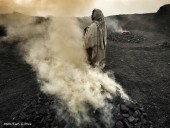Letter from the GAHP Secretariat
Richard Fuller, Founder, Blacksmith Institute for a Pure Earth.
When I first visited Kabwe, Zambia in 2004 I saw a crowd of people gathered around a young man who was sitting on the ground staring blankly at his feet. He had just been pulled out of a hole where he had been digging in mining waste, and it had collapsed around him. His best friend had been killed. They were both teenagers, invincible, and now one of them was dead.
They had been scavenging for lead scrap in the mine tailings near a long-disused lead smelter. Since the early 1900s Kabwe had mined and smelted the lead used in the bullets of the armies of the British Empire through two World Wars and more. At the time, the rich ore near the smelter was one of the largest finds of its kind. But the smelter had closed in the 1990s and the town was now a wreck with 200,000 or more people living from hand to mouth with no industry to sustain them. To make a simple living, people were scavenging wherever they could. There were dozens, maybe a hundred, working over the scrap lead pile that spread for many hectares. Collapses like the one I witnessed were commonplace.
But the problems in Kabwe were much deeper than a collapsed hole in a pile of mining waste. Lead is toxic, an acute neurotoxin that causes permanent brain damage. I checked with other scavengers and the symptoms of lead poisoning were clear: Their hands shook, some could not walk without a strange waddling action; Some had an inability to concentrate for very long, and I saw a blankness in the eyes that was terribly, terribly disturbing. It hurt me deeply to see these young men, well on their way to a certain and early death.
This is what pollution does. It kills people before their time. And along the way it damages both their bodies and their minds. It causes unnecessary misery. It destroys those who cannot get away. It hurts the poor most, trapping them a cycle of bad health and thus crippling their ability to work and provide for their families.
It need not be like this. We know this can be changed because we have done it. The richer countries no longer have these problems. Since the 1950s and 60s, in the US and Europe, a consistent and steady effort has eradicated the worst of our toxic nightmares. Places like Kabwe no longer exist in the North thanks to awareness, regulations, remediation programs, careful controls on industry and mining. In wealthy countries the air is (mostly) clean, the water drinkable, and the soil around us free of toxins. We are all safer for it.
Now is our chance to replicate this success in the rest of the world. Some work has been done, and much more is needed. This report outlines where we see success, and where we see more effort needed in ten countries across all continents. These are stories proving we are on the right track, and moving forward. But we need to do more with industrialization in full swing around the world. Today pollution kills nearly 9 million people while more than 200 million people worldwide suffer from ailments, diseases, sicknesses. This need not be so.
Investments from the international community will serve the poorest well, saving lives, and solving problems permanently. We know how to solve the problem. It is simply a matter of providing communities and govern-ments with the tools to get the job done now.
Join us in bringing effective, low-cost solutions to prevent the terrible damage pollution is causing.
Rich
Richard Fuller





